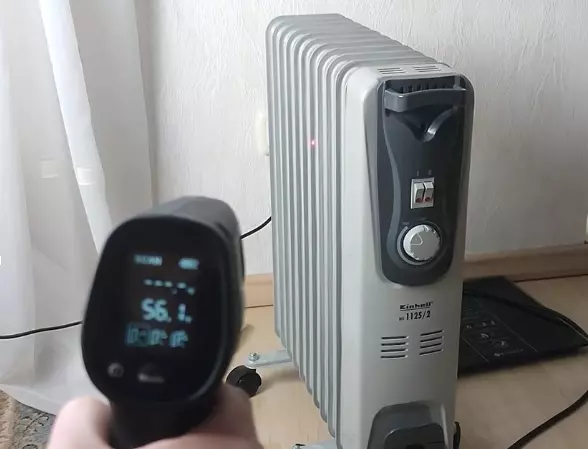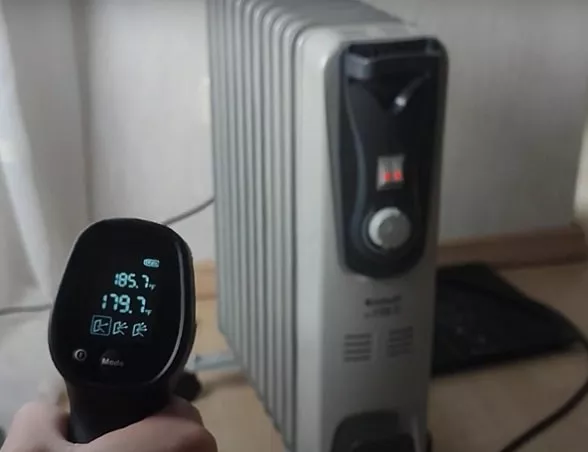Your oil-filled radiator doesn’t get hot? I’m going to share some of the potential causes of why your oil-filled radiator is not getting hot so that you can check and fix those problems and get your heater running again
Quick Answer: Oil-filled radiators stop heating because of a broken thermostat. Also, the thermostat can cut off the heating if the room is already warm. Furthermore, oil-filled radiators will not start and get hot if the power supply and extension cord are faulty.
Why is my Oil-filled radiator not getting hot?
Here is the full list of causes and fixes for your oil-filled radiator not heating!
#1 Broken Thermostat
Thermostats measure your room’s temperature. And based on the temperature, they set the heating element’s input power.
A broken thermostat either does not measure the temperature of your room properly. Or it miscalculates the heating power of the heater.
How to check: If your oil-filled radiator has a room temperature display, check it and see if it shows a plausible value.
If the current room temperature reading is off, then it’s likely that your thermostat’s built-in thermometer is broken.
Unfortunately, testing whether a thermostat is broken without such a temperature display is not straightforward.
How to fix: To fix the thermostat, you will need a good understanding of electronics. Usually, you will have to replace either individual electronic parts on it, or the entire thing.
If you don’t know how to do it, just buy a new oil-filled radiator. They are inexpensive and it will save you a ton of troubleshooting time.
For replacing the entire thermostat, first, make sure you’re buying the right one for your oil-filled heater.
Ideally, you should take a picture of the old thermostat installed, then remove it, and wire up your new thermostat according to the picture you took earlier.
#2 Room is warm enough already
The built-in thermostat activates the heating only if your room is colder than the temperature you set on the heater.
So, if your room is warm enough already, then the thermostat will not allow the oil-filled radiator to heat up until the room is cold again.
How to check: Check your heat settings on the heater’s front panel (if there is one) and the temperature of your room. If your room is warm already, then you’ve found the reason.
Alternatively, you could try running your oil-filled radiator outdoors (in the cold), and see whether it turns on there. If it works outdoors, but not indoors, that’s a sign of your room being warm enough.
How to fix: Increase the heating setting.
#3 Thermostat is set to a too-low temperature
It’s not always the case that your oil-filled radiator is at fault when it’s not getting hot. Your heater may not get hot if you’ve set your heater at a very low heat setting.
This issue is related to the previous one. If you set your heater at a very low setting and your room temperature is already above your desired temperature, your heater will not get hot.
How to check: Check your settings on the front panel of your oil-filled radiator; if it’s very low, you’ve found the problem.
How to fix: You need to change the setting of your oil-filled radiator from low to high enough. You can start from 5 degrees and if it does not heat enough, then increase it by 5 again.
Or just set it to full power and see if your oil-filled radiator finally turns on.
#4 Faulty Power supply or Extension Cord
A power supply provides power to the oil-filled radiator to allow it to heat up and increase the temperature of the surroundings.
If there is an issue in the power supply, the heater will not get the desired power to work; hence it will not heat up.
Apart from power supply issues, there is a possibility that the extension cord you’re using with your space heater is faulty and not providing current to your heater.
How to check:
- Ensure it is adequately plugged (it might have loosened).
- Check for damage, bite, or sparks.
- You can plug your power cord into other outlets to ensure the power supply outlet is not faulty,
- You can use a multimeter to check the power supply and extension cord (Set the knob to voltage or current, connect in parallel to the connections in case of voltage, and series to the circuit in case of current. Check if the multimeter is giving a correct reading or not).
How to fix:
- In case of a faulty outlet, you need to replace the socket or get one that can withstand the load of the heater,
- If the power cord is damaged, you can use tape to fix it temporarily. However, I’d recommend buying a new extension cord with a good current handling capacity (ampere rating)
#5 Overheat-protection triggered through blocked airways
It could be that your oil-filled radiator has a built-in auto shut-off feature that triggers upon sensing blocked airways.
This feature cuts off the heat, if anything, covers the radiator part of the heater to ensure safety and prevent hazards.
How to check: You need to check if something is covering the radiator part of the heater, i.e., a piece of cloth or a curtain.
How to fix: Remove anything that traps heat from your oil-filled radiator’s surroundings. Your radiator should always keep distance from the curtains.
If you put a blanket over your oil-filled radiator to warm you up better, or you run your radiator under a desk, place your oil-filled radiator in an open space (in the center of your room) and try running it there.
#6 Tip-over protection active
The oil-filled radiator has a tip-over protection feature that prevents it from turning on when it is not on level ground.
How to check: If your oil-filled heater is tilted, not standing firmly on the ground, or lying on its side, tip-over protection will protect it from turning on.
You can try tilting your oil-filled radiator (while it’s turned on) back and forth and see whether you hear any clicking sound (that’s the tip-over protection).
How to fix: Place your heater on solid ground. Try to install your heater on even ground or a hard surface.
If it still doesn’t turn on, try shaking the heater and see whether that triggers the tip-over protection and turns on the heater.
In case your heater only turns on after shaking, that’s a sign that the tip-over protection is “stuck”. In this case, you should get a new heater.
If you’re done checking everything from my list, and your space heater is not heating up, and it’s already too old to get repaired, again and again, it’s time to buy a new one.
Here’s my favorite one: My recommended Oil-Filled Radiator
Maintenance tips for oil-filled radiators
In cold regions, specifically, oil-filled radiators are necessary, but these radiators need maintenance; otherwise, they can lead to dangerous accidents or be worn out early.
To avoid mishaps and a longer life span for your oil-filled radiator heater, I will give you a few tips.
- Never choose to put your radiator near windows or curtains; simply put it at least 3 feet away from anything; it could be clothes or furniture.
- Avoid putting the power cords or extensions under mats or carpets in your room
- You can leave it on overnight, but make sure to turn it off if you are going out for a day or more.
- Do not use it in the bathroom; simply put it away from water or liquid.
- Never wrap the power cords right after turning the radiator off.
- Make sure to service your oil-filled radiator to avoid rusting and clean it.
- Clean the radiator while it’s cool with a dry, clean and soft cloth. It will be ideal to use a vacuum or dryer to clean it. (as it will be able to reach where you cannot).
- Clean the tubes, pipes, inlets, and outlets to avoid obstruction.
- The radiator should be balanced, not tiled or lying on the side.
- Always put your oil-filled radiator in a good-ventilated room or space.
Are oil-filled heaters hot to the touch?
Usually, the thing which gets too hot to touch in a heater is the heating element.
The heating element sits inside the heater’s metal body. So, it’s impossible to touch it directly.
So, the metal surface gets hot, but not extremely hot. Mostly, you can easily touch it for a few seconds.
How long does it take for an oil-filled radiator to heat up?
The time an oil-filled radiator takes depends on the size of your oil-filled radiator and the space in which you are using it.
Like, it will take more than 30 minutes to heat up the room properly if you use a small radiator in a large space.
However, a working radiator takes 5-10 minutes to warm up. The heat has to move from the heating element embedded in the oil-filled radiator to the metal surface.
To get an accurate answer to how long it takes for an oil-filled radiator to heat up, I experimented with my own heater!
Here are the highlights of how I experimented with my oil-filled heater:
- I checked the initial temperature of the radiator area using a laser thermometer when the heater was not turned on. It was 56°F.
- I switched on my space heater on full power.
- In 5 minutes, the temperature of the radiator area increased from 56°F to approximately 180°F.
- I also noticed that the bottom part heated up faster than the top part (likely because the heating element is located in the lower part).
So, after running your heater for 5 minutes, it should be hot to the touch!
The temperature immediately after turning it on:

Temperature after 5 minutes of running:

So, if your oil-filled heater is not getting hot like mine, there must be an issue. I’ve mentioned every possible issue in this article, along with troubleshooting and fixing guides.
